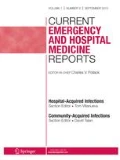Abstract
Purpose of Review
Disposition decisions of psychiatric patients in the emergency department are challenging in hospitals without rapid access to psychiatric professionals. There is a movement towards more outpatient management of psychiatric patients in response to inpatient bed shortages and more appropriate use of resources. If there were a good modality of risk assessment for suicidal patients, then it would be possible that the ER physician could discharge more patients home following evaluation. These options would allow for better throughout and less cost incurred by the patient and healthcare system.
Recent Findings
Currently, the severity of psychiatric illness (SPI) and crisis triage rating scale (CTRS) are not reliable modalities of risk stratifying psychiatric patients. More research and training are needed on developing quick, reliable ways to stratify these patients thereby not only improving disposition time but also improving care. Patients with new or worsening psychosis or mood disorder must have a thorough psychiatric exam performed. In addition, information from collateral sources should be collected when determining disposition.
Summary
This article reviews the thought process and risk stratification modalities that should be considered when determining disposition selection in emergency rooms without readily available psychiatric services. Although the SPI rating scale and the CTRS provide some guidance in this decision, ER providers should also consider psychosocial factors, collateral information, and judgment.
Similar content being viewed by others
References
Papers of particular interest, published recently, have been highlighted as: •• Of major importance
•• Chakravarthy B, Menchine M. Psychiatric patient disposition agreement between the emergency physician consultant. Crisis. 2013;34:354–62. This article discusses high PPV and moderate NPV for ER admission decisions regarding psychiatric patients presenting to the ER. This sheds light on the ability of the ER to appropriately decide who should be admitted but our downfalls in deciding who can be discharged home safely
•• Wiler JL, Brown NA. (2014). Care of the psychiatric patient in the emergency department. Retrieved December 19, 2016, from ACEP: https://www.acep.org/uploadedFiles/ACEP/Clinical_and_Practice_Management/Resources/Mental_Health_and_Substance_Abuse/Psychiatric%20Patient%20Care%20in%20the%20ED%202014.pdf This article discusses the shortcomings of inpatient psychiatric beds and decreasing availability. This article nicely discusses alternative dispositions besides inpatient admission for psychiatric patients.
Lyons JS, Colletta J. Validity of the severity of psychiatric illness rating scale in as sample of inpatients on a psychogeriatric unit. Int Psychogeriatr. 1995;7:407–16.
Way B. Relationship between patient, family and significant other disposition preferences in psychiatric emergency services and the clinical symptom rating and disposition decisions of psychiatrists. Psychiatric Rehabilitation Journal. 2005;29:132–7.
Kuo DC, Tran M. Depression and the suicidal patient. Emerg Med Clin N Am. 2015;33:765–78.
Colucciello SA. Mood Disorders. In: Hockberger R-H, Marx JA, editors. Rosen’s emergency medicine. Amsterdam: Elsevier; 2014. p. 1492–500.
Brown H. How to stabilize an acutely psychotic patient. Curr Psychiatr Ther. 2012;11:10–6.
Hockberger RS, R. J. Thought disorders. In: Hockberger R-H, Marx JA, editors. Rosens emergency Meidicine. Amsterdam: Elsevier; 2014. p. 1460–5.
Mental Status Exam. (n.d.). Retrieved Jan 2, 2017, from The Royal Children's Hospital Melbourne: http://www.rch.org.au/clinicalguide/guideline_index/Mental_State_Examination/
Lyons JS, Stutesman J. Predicting psychiatric emergency admissions and hospital outcome. Med Care. 1997;35:792–800.
Bengelsdorf H, Levy LE. A crisis triage rating scale: brief dispositional assessment of patients at risk for hospitalization. The Hournal of Nervous and Mental Disease. 1984;172:424–30.
Turner PM, Turner TJ. Validation of the crisis triage raring scale for psychiatric emergencies. Can J Psychiatr. 1991;36:651–4.
Sledge WH, Tebes J. Day hospital/crisis respite care versus inpatient care, part I: clinical outcomes. Am J Psychiatry. 1996;153:1065–73.
•• Goodwin R, Lyon JS. An emergency housing program as an alternative to inpatient admission. Psychiatr Serv. 2001;52:92–5. This article discusses that outpatient emergency psychiatric housing is a reasonable alternative to inpatient admission for psychiatric patients with “serious and persistent mental illness.” A less formal setting such as this emergency housing may even allow for faster improvement of symptoms
Brooker C, E. D. (2007). Admission decisions follow contact with an emergency mental health assessment and intervention service. Journal of Clinical Nursing, 16:1313–1322.
Support Safe Care and Transitions and Create Organizational Linkages. (2017). Retrieved January 14, 2017, from Suicide Prevention Resource Center: http://www.sprc.org/comprehensive-approach/transitions-lInkages
Author information
Authors and Affiliations
Corresponding author
Ethics declarations
Conflict of Interest
The authors declare that they have no conflict of interest.
Human and Animal Rights and Informed Consent
This article does not contain any studies with human or animal subjects performed by any of the authors.
Additional information
This article is part of the Topical Collection on Behavioral Health
Rights and permissions
About this article
Cite this article
Flynn, S.W., Zun, L.S. Disposition Decisions for Psychiatric Patients Presenting to the Emergency Department. Curr Emerg Hosp Med Rep 5, 103–107 (2017). https://doi.org/10.1007/s40138-017-0133-6
Published:
Issue Date:
DOI: https://doi.org/10.1007/s40138-017-0133-6



